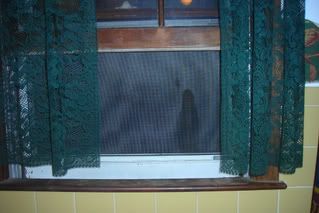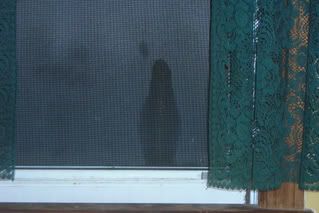
This is the upstairs bathroom in my girlfriend’s childhood home. It was a suburban Massachusetts open-window summer night loud with crickets. “Buzz, come see this,” she shouted from the stairs. Crawling out of the couch, I heeded her call. On the stairs she stood, pointing at the bathroom. “It’s a Virgin Mary,” she said, devilishly. “Where?” “On the screen.”

Sure enough, the belled shape I have seen on all sorts of substrates stood before me on the screen in the bathroom window. News of the discovery ran rampant through the house and the image’s story emerged. My lady’s sister’s fiancé had killed an insect with some sort of laundry spray, out of spite I suppose. This Mary’s head is where the close-proximity spray hit, her body the stain left in the wake of the chemical drip. Appropriate, if you consider that Mary bore a son whose purpose was to die.
An eternal story, really, one that gets reinterpreted time and again. Another type of story that gets told over and over, especially over the last 20 years or so, is the story of the unexpected visual manifestation of a religious or secular icon. On this very blog and in Madonna of the Toast you can find mentions of The Simpsons, films about a Jesus screen door and a tortilla, and a play about a Jesus hickey!
Of late, two new fictional homages to these phenomena have come to my attention. The first is older but totally new to me: the Seinfeld episode “The Merv Griffin Show.” A new sidling co-worker of Elaine’s startles her and she spills coffee on her sleeve. Another co-worker thinks it looks like Fidel Castro. When she shows up at Monk’s and scooches into the booth next to George, he sees Art Garfunkel. I laughed my ass off watching this one. Leave it to the Seinfeld writing crew to identify a surprisingly relevant, if not oft ignored, cultural topic with great significance, even if its impact may be lost on most.

The second riff comes in book form, Jesus in the Mist by Paul Ruffin. I have not read this book. I don’t even own it. I stumbled upon it here in the cyber ether. Apparently the title story “tells of a man who leaves his wife and home because he sees Jesus' image in the foggy mirror of a Holiday Inn. He's able to re-create the image with a vaporizer in the back of his truck and travels the South collecting monetary tributes for the miraculous vision,” according to this review from the South Bend Tribune. I can’t say anything about Ruffin’s writerly chops, but I give him props for shaping a story around this topic. I’ve often thought about blending a few of the people and objects I’ve encountered in these parts into a short story, if not a novel.
No one has ever accused Madonna of the Toast of being a bad idea. Because it involves faith, belief and identity, some folks feel differently about it than others, but on the whole, most people have a frame of reference for the subject. That alone validates it, but all of these echoes created by writers, filmmakers and visual artists really drive home for me the extent to which these stories have cultural traction. We read about them and think about them, are reminded of them when we walk home and stare up at the clouds. When it comes across in a self-aware form (a short story, a screenplay, a cast iron pan) it works because it doesn’t come off an unbelievable. These things happen all the time.



No comments:
Post a Comment